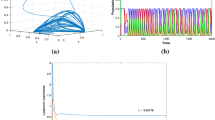Abstract
This paper describes a prey–predator type fishery model with prey dispersal in a two-patch environment, one of which is a free fishing zone and other is a protected zone. The existence of possible steady states, along with their local stability, is discussed. A geometric approach is used to derive the sufficient conditions for global stability of the system at the positive equilibrium. Relative size of the reserve is considered as control in order to study optimal sustainable yield policy. Subsequently, the optimal system is derived and then solved numerically using an iterative method with Runge–Kutta fourth-order scheme. Numerical simulations are carried out to illustrate the importance of marine reserve in fisheries management. It is noted that the marine protected area enables us to protect and restore multi-species ecosystem. The results illustrate that dynamics of the system is extremely interesting if simultaneous effects of a regulatory mechanism like marine reserve is coupled with harvesting effort. It is observed that the migration of the resource, from protected area to unprotected area and vice versa, is playing an important role towards the standing stock assessment in both the areas which ultimately control the harvesting efficiency and enhance the fishing stock up to some extent.












Similar content being viewed by others
References
Bhattacharyya, J., Pal, S.: Stage-structured cannibalism with delay in maturation and harvesting of an adult predator. J. Biol. Phys. 39(1), 37–65 (2013)
Banerjee, S., Chakrabarti, C.G.: Non-linear bifurcation analysis of reaction diffusion actilvator-inhibator system. J. Biol. Phys. 25(1), 23–33 (1999)
Kvamsdal, S.F., Sandal, L.K.: The premium of marine protected areas: a simple valuation model. Mar. Resour. Econ. 23, 171–197 (2008)
Hannesson, R.: The economics of marine reserves. Nat. Resour. Model. 15, 273–290 (2002)
Sumalia, U.R.: Economic models of marine protected areas: an introduction. Nat. Resour. Model. 15, Number-3 (2002)
Neubert, M.G.: Marine reserves and optimal harvesting. Ecol. Lett. 6, 843–849 (2003)
Flaaten, O., Mjølhus, E.: Using reserves to protect fish and wildlife—simplified modeling approaches. Nat. Resour. Model. 18(2), 157–182 (2005)
Sumalia, U.R.: Marine protected area performance in a model of the fishery. Nat. Resour. Model. 15, Number-4 (2002)
Sumaila, U.R.: Protected marine reserves as fisheries management tools: a bioeconomic analysis. Fish. Res. 37, 287–296 (1998)
Takashina, N., Mougi, A., Iwasa, Y.: Paradox of marine protected areas: suppression of fishing may cause species loss. Popul. Ecol. 54(3), 475–485 (2012)
Wang, W., Takeuchi, Y.: Adaptation of prey and predators between patches. J. Theor. Biol. 258(4), 603–613 (2009)
Mougi, A., Iwasa, Y.: Unique coevolutionary dynamics in a predator–prey system. J. Theor. Biol. 277(1), 83–89 (2011)
Luck, T., Clark, C.W., Mangel, M., Munro, G.R.: Implementing the precautionary principles in fisheries management through marine reserves. Ecol. Appl. 8(1), 72–78 (1998)
Hartmann, K., Bode, L., Armsworth, P.: The economic optimality of learning from marine protected areas. ANZIAM. 48, C307–C329 (2007)
Dubey, B.: A prey–predator model with a reserved area. Nonlinear Anal. Model. Control. 12(4), 479–494 (2007)
Flaaten, O., Mjølhus, E.: Nature reserves as a bioeconomic management tool: a simplified modeling approach. Environ. Resour. Econ. 47, 125–148 (2010)
Sanchirico, J.N.: Marine Protected Areas as Fishery Policy: A Discussion of Potential Costs and Benefits. Resources for the Future Discussion Papers Washington, DC (2000)
Boncoeur, J., Alban, F., Guyader, O., Thebaud, O.: Fish, fishers, seals and tourists: economic consequences of creating a marine reserve in a multi- species, multi-activity context. Nat. Resour. Model. 15(4), 387–411 (2002)
Sandal, L.K., Steinshamn, S.I.: A simplified approach to optimal resource management. Nat. Resour. Model. 14(3), 419–432 (2001)
Bohnsack, J.A.: Marine reserves: they enhance fisheries, reduce conflicts, and protect resources. Oceanus 36:33, 63–71 (1993)
Anderson, L.G.: A bioeconomic analysis of marine reserves. Nat. Resour. Model. 15(3), 311–334 (2002)
Sobel, J.: Conserving biological diversity through marine protected areas. Oceanus 36(3), 19–26 (1993)
Hannesson, R.: Marine reserves: What would they accomplish? Mar. Resour. Econ. 13, 159–170 (1998)
Dixon, J.A: Economic benefits of marine protected areas. Oceanus 36(3), 35–40 (1993)
Conard, J.M.: The bioeconomics of marine sanctuaries. J. Bio Econ. 1, 205–217 (1999)
Srinavasu, P.D.N., Gayetri, I.L.: Influence of prey reserve capacity on predator prey dynamic. Ecol. Model. 181, 191–202 (2005)
Dubey, B., Chandra, P., Sinha, P.: A model for fishery resource with reserve area. Linear Anal: Real World Appl. 4, 625–637 (2003)
Kar, T.K.: A model for fishery resource with reserve area and facing prey- predator interactions. Can. Appl. Math. Quart. 14(4), 385–399 (2006)
Kar, T.K., Chakraborty, K.: Marine reserves and its consequences as a fisheries management tool. World J. Mod. Simul. 5(2), 83–95 (2009)
Kar, T.K., Chakrabarty, K.: Effort dynamics in a prey–predator model with harvesting. Int. J. Inf. Syst. Sci. 6(3), 318–332 (2010)
Arditi, R., Ginzburg, L.R.: Coupling in predator–prey dynamics: ratio- dependence. J. Theor. Biol. 139, 311–326 (1989)
Clark, C.W.: Mathematical Bioeconomics: The optimal Management of Renewable Resources, 2nd edn. Wiley, New York (1990)
Chakraborty, K., Chakraborty, M., Kar, T.K.: Regulation of a prey–predator fishery incorporating prey refuge by taxation: a dynamic reaction. J. Biol. Syst. 19(3), 417–445 (2011)
Chakraborty, K., Jana, S., Kar, T.K.: Global dynamics and bifurcation in a stage structured prey–predator fishery model with harvesting. Appl. Math. Comput. 218(18), 9271–9290 (2012)
Li, M.Y., Muldowney, J.S.: A geometric approach to global stability problems. SIAM J. Math. Anal. 27(4), 1070–1083 (1996)
Bunomo, B., Onofrio, A., Lacitignola, D.: Global stability of an SIR epidemic model with information dependent vaccination. Math. Biosci. 216(1), 9–16 (2008)
Martin, R.H. Jr.: Logarithmic norms and projections applied to linear differential systems. J. Math. Anal. Appl. 45, 432–454 (1974)
Workman, J.T., Lenhart, S.: Optimal control applied to biological models. Chapman and Hall/CRC (2007)
Chakraborty, K., Das, K., Kar, T.K.: Combined harvesting of a stage structured prey–predator model incorporating cannibalism in competitive environment. Comptes Rendus—Biologies. 336(1), 34–45 (2013)
Hackbush, W.: A numerical method for solving parabolic equations with opposite orientations. Computing 20(3), 229–240 (1978)
Acknowledgement
The first author also gratefully acknowledges Director, INCOIS for his encouragement and unconditional help. We are also thankful to Mr. Nimit Dilip Joshi for helping us in proof reading of the manuscript. This is INCOIS contribution number 150.
Author information
Authors and Affiliations
Corresponding author
Rights and permissions
About this article
Cite this article
Chakraborty, K., Das, K. & Kar, T.K. An ecological perspective on marine reserves in prey–predator dynamics. J Biol Phys 39, 749–776 (2013). https://doi.org/10.1007/s10867-013-9329-5
Received:
Accepted:
Published:
Issue Date:
DOI: https://doi.org/10.1007/s10867-013-9329-5




